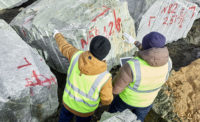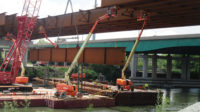Between COVID-19, the five named storms that hit the state in 2020 and the industry’s ever-present labor shortage, Louisiana contractors have spent the last year trying to get by with a maxed-out workforce and pandemic-related supply chain shortages.
Hurricane Ida didn’t make things any easier.
Contractors are bracing for materials and labor to become even harder to come by, which could translate into more costs and longer construction timelines while the state recovers from the Aug. 29 hurricane.
“There will certainly be adverse impacts to both time and cost due to the storm,” says J.J. Hickey, project manager for Gilchrist Construction.
Several firms, including Gilchrist, could not resume work on jobsites until Sept. 13 because of widespread utility outages. Gilchrist is lead contractor on the $126-million Interstate-10 flyover ramp project in Kenner, La.
“At a minimum, we have now lost two full weeks of progress,” Hickey says of the project. “We are attempting to resume work this week, but it will take a bit of time to get back to full production.”
Ken Naquin, CEO of the Louisiana Associated General Contractors, says local contractors will feel the greatest impact in the hard-hit rural parishes of Lafourche, Terrebonne, St. Charles, St. James, St. John the Baptist and lower Jefferson. “Keep in mind that most of the damage is to small commercial and residential, so those industries will be taxed,” he says.
Naquin doesn’t anticipate too much of a jump in cost for materials, but he does expect availability to be a concern. “Gypsum board and roofing materials are all going to be in high demand. And particularly plastic pipe plumbing, which is very difficult to get today,” he says.
Fuel sources and inaccessible roadways have made it even harder to truck in supplies. “The roadways have to be clear and safe for supplies to be able to get in there and for people to be able to work,” says Jason Latiolais, vice president of asphalt operations for Barriere Construction of Metairie, La., which has been performing emergency work for the Louisiana DOTD to repair washed-out areas along La. 1 in the coastal town of Grand Isle, La.
Otis Tucker Jr., CEO of New Orleans-based T.I. Contracting LLC, says supply chain disruptions have been an ongoing problem, and Ida is only making it harder to buy equipment. “Right now we’re ordering trucks and waiting six months to a year for trucks to get built and sent to us,” he says.
Although many workers have returned, labor continues to be a challenge with some still displaced. “We have employees right now who can’t come back to work because they either don’t have a home or have a home that’s badly damaged and can’t live in it, or they don’t have any power or water or sewer,” Latiolais says.
Another potential labor issue, says Naquin, is President Joe Biden’s plan to mandate COVID-19 vaccines or weekly testing for all U.S. firms with over 100 workers. “We expect to lose 40% of our workforce that will just quit in lieu of a vaccine mandate,” he says.
Lauren Gibbs, CEO of Gibbs Construction , Harahan, La., says working remotely has helped keep operations going. “The jobsites are also accustomed to working without grid power, and much of work can proceed either on generator support or simply without power,” she says.
Wes Palmisano, CEO of New Orleans contractor Palmisano LLC, says the storm is forcing his firm to find creative ways to source labor, materials and equipment.
“We went through Katrina here in New Orleans,” Palmisano says. “And that experience taught us about being resilient and resourceful, and finding ways to make things happen under difficult circumstances. I think the same applies here.”



.jpg?height=200&t=1671747499&width=200)

Post a comment to this article
Report Abusive Comment